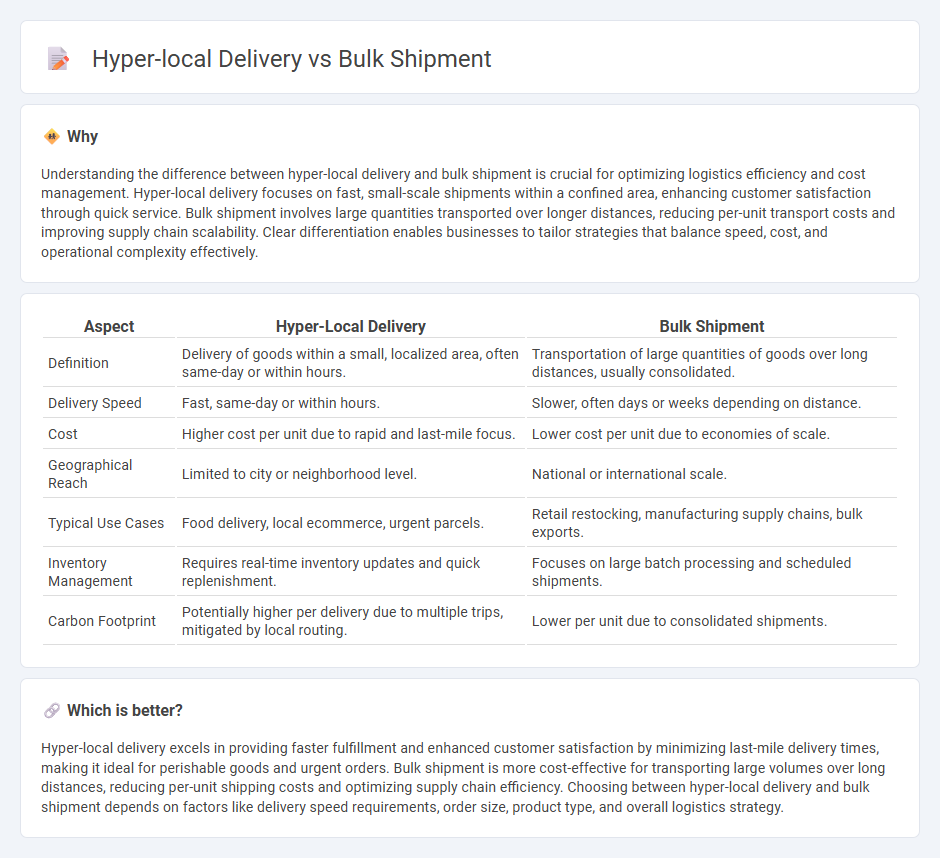
Hyper-local delivery focuses on transporting goods within a confined geographic area, enabling faster delivery times and meeting immediate customer demands. Bulk shipment involves moving large quantities of products over long distances, optimizing cost-efficiency and supply chain scalability. Explore the benefits and challenges of both methods to enhance your logistics strategy.
Why it is important
Understanding the difference between hyper-local delivery and bulk shipment is crucial for optimizing logistics efficiency and cost management. Hyper-local delivery focuses on fast, small-scale shipments within a confined area, enhancing customer satisfaction through quick service. Bulk shipment involves large quantities transported over longer distances, reducing per-unit transport costs and improving supply chain scalability. Clear differentiation enables businesses to tailor strategies that balance speed, cost, and operational complexity effectively.
Comparison Table
| Aspect | Hyper-Local Delivery | Bulk Shipment |
|---|---|---|
| Definition | Delivery of goods within a small, localized area, often same-day or within hours. | Transportation of large quantities of goods over long distances, usually consolidated. |
| Delivery Speed | Fast, same-day or within hours. | Slower, often days or weeks depending on distance. |
| Cost | Higher cost per unit due to rapid and last-mile focus. | Lower cost per unit due to economies of scale. |
| Geographical Reach | Limited to city or neighborhood level. | National or international scale. |
| Typical Use Cases | Food delivery, local ecommerce, urgent parcels. | Retail restocking, manufacturing supply chains, bulk exports. |
| Inventory Management | Requires real-time inventory updates and quick replenishment. | Focuses on large batch processing and scheduled shipments. |
| Carbon Footprint | Potentially higher per delivery due to multiple trips, mitigated by local routing. | Lower per unit due to consolidated shipments. |
Which is better?
Hyper-local delivery excels in providing faster fulfillment and enhanced customer satisfaction by minimizing last-mile delivery times, making it ideal for perishable goods and urgent orders. Bulk shipment is more cost-effective for transporting large volumes over long distances, reducing per-unit shipping costs and optimizing supply chain efficiency. Choosing between hyper-local delivery and bulk shipment depends on factors like delivery speed requirements, order size, product type, and overall logistics strategy.
Connection
Hyper-local delivery relies on efficient bulk shipment strategies to consolidate large volumes of goods before distributing them to nearby customers, reducing transportation costs and delivery times. Bulk shipments optimize inventory management and minimize last-mile delivery challenges by centralizing product flow in regional hubs. This synergy enhances supply chain responsiveness and supports sustainable logistics practices through fewer, fuller vehicle loads.
Key Terms
Freight Consolidation
Freight consolidation enhances efficiency by combining multiple smaller shipments into a single bulk shipment, reducing transportation costs and minimizing environmental impact. In contrast, hyper-local delivery emphasizes rapid, direct distribution within a confined geographic area, prioritizing speed and convenience over volume. Explore the advantages and challenges of freight consolidation versus hyper-local delivery to optimize your supply chain strategy.
Last-Mile Delivery
Bulk shipment minimizes transport costs by consolidating large orders, optimizing backhaul efficiency, and reducing frequency of deliveries in last-mile logistics. Hyper-local delivery enhances customer satisfaction through rapid order fulfillment, real-time tracking, and direct-to-consumer service within dense urban areas. Explore how integrating bulk shipment strategies with hyper-local delivery innovations can transform last-mile delivery performance.
Delivery Radius
Bulk shipment typically covers a wide delivery radius, often spanning cities, regions, or even countries, making it ideal for large-scale distribution across vast distances. Hyper-local delivery focuses on a very narrow delivery radius, usually within a few miles or a specific neighborhood, ensuring rapid and precise order fulfillment. Explore more about optimizing delivery radius strategies for your business needs.
Source and External Links
Bulk Shipping: Mass Shipping & Shipping Large Quantities - Bulk shipping involves transporting large quantities of goods without packaging, often suited for B2B and wholesale businesses.
The Difference Between Bulk and Break Bulk Cargo - This webpage explains the distinction between bulk and break bulk cargo, highlighting their respective shipping methods.
All You Need to Know About Different Bulk Shipping Options - Provides an overview of various bulk shipping options, including bulk vessels and ISO tank containers, with their advantages and disadvantages.
 dowidth.com
dowidth.com